PROBLEMS ON ISOSCELES TRAPEZOID WITH DIAGONALS
Subscribe to our ▶️ YouTube channel 🔴 for the latest videos, updates, and tips.
What is Trapezium ?
A trapezium is a convex quadrilateral with exactly one pair of opposite sides parallel to each other. The trapezium is a two-dimensional are called legs. It is also called a trapezoid. Sometimes the parallelogram is also called a trapezoid with two parallel sides.
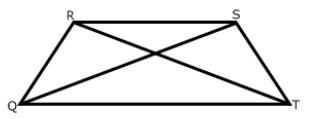
Diagonals are congruent.
Find the length of the diagonal indicated for each trapezoid.
Problem 1 :
DF = 9.1, Find CE
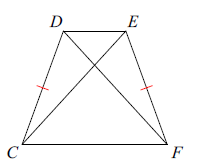
Solution :
CE and DF are diagonals.
DF = 9.1, so CE = 9.1
Solve for x. Each figure is a trapezoid.
Problem 2 :
DF = 6 and CE = 2x - 10
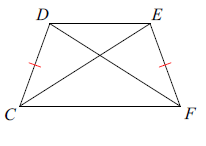
Solution :
DF and CE are diagonals. So, they are equal.
6 = 2x - 10
2x = 6 +10
2x = 16
x = 16/2
x = 8
Problem 3 :
DF = 12 and EG = -2x + 36
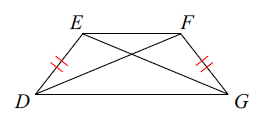
Solution :
DF and EG are diagonals, so they are equal.
DF = EG
12 = -2x + 36
12 - 36 = -2x
-24 = -2x
x = 24/2
x = 12
Find the length of the diagonal indicated for each trapezoid.
Problem 4 :
JL = 2x + 4, KM = 4x - 8. Find JL
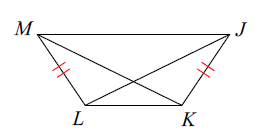
Solution :
JL and KM are diagonals.
JL = MK
2x + 4 = 4x - 8
2x - 4x = -8 - 4
-2x = -12
dividing by -2 on both sides.
x = 12/2
x = 6
Problem 5 :
UW = 3x + 11, TV = 8x - 9 and Find UW
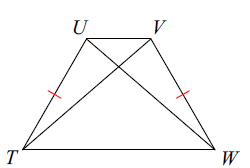
Solution :
UW and TV are diagonals.
UW = TV
3x + 11 = 8x - 9
Subtracting 8x and 11, we get
3x - 8x = -9 - 11
-5x = -20
x = 20/5
x = 4
Problem 6 :
The bases of an isosceles trapezoid ABCD measure 10 cm and 20 cm. The height (altitude) is 12 cm. How long are the legs AB and CD?
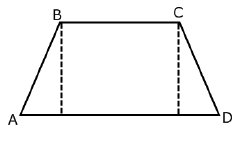
Solution :
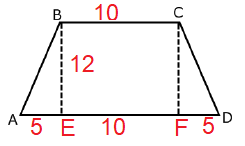
In triangle ABE,
AB2 = AE2 + BE2
AB2 = 52 + 122
AB2 = 25 + 144
AB2 = 169
AB = 13
Since is it isosceles trapezoid, CD is 13.
Problem 7 :
In isosceles trapezoid KIME, <K and <E are the base angles. If IK = 11 and ME = 3x - 1, what is the value of x?
Solution :
In KIME, KI and ME are non parallel sides.
IM and KE are parallel sides.
Non parallel sides will be equal in length.
IK = ME
11 = 3x - 1
Add 1 on both sides.
11 + 1 = 3x
3x = 12
x = 12/3
x = 4
Problem 8 :
𝐴𝐵𝐶𝐷 is an isosceles trapezoid with bases 𝐴𝐵 and 𝐷𝐶. If 𝐴𝐷 = 3x+4 and 𝐵𝐶 = x+12. Find the value of x and the length of 𝐴𝐷.
Solution :
AD = BC
3x + 4 = x + 12
3x - x = 12 - 4
2x = 8
x = 8/2
x = 4
Subscribe to our ▶️ YouTube channel 🔴 for the latest videos, updates, and tips.
Recent Articles
-
Finding Range of Values Inequality Problems
May 21, 24 08:51 PM
Finding Range of Values Inequality Problems -
Solving Two Step Inequality Word Problems
May 21, 24 08:51 AM
Solving Two Step Inequality Word Problems -
Exponential Function Context and Data Modeling
May 20, 24 10:45 PM
Exponential Function Context and Data Modeling